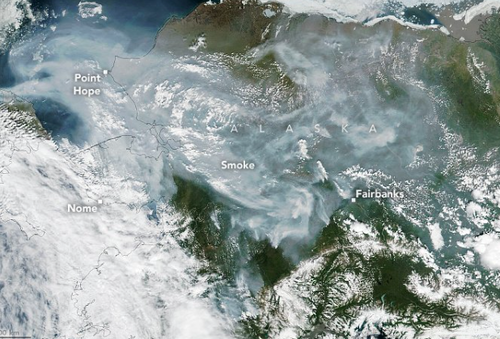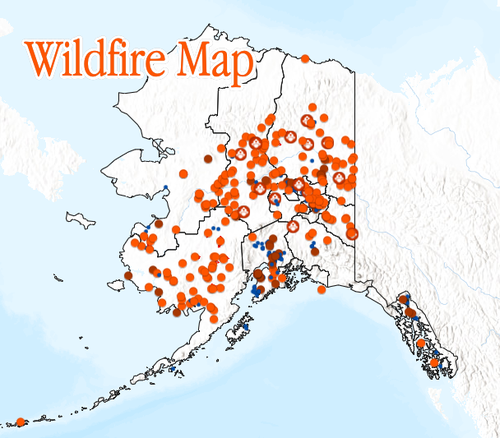
Alaska's fire season is off to a fiery start, possibly a historic one as more than 2 million acres burned, the earliest date for this milestone in decades.
As of Wednesday, more than 200 wildfires rage across the state, with worsening air quality over the central and eastern interior and the western Yukon Territory, Alaska Wildland Fire Information noted on their website.
Fairbanks Airport now approaching 300 hours with visibility reducing #wildfire smoke, all since June 12. This is already the fifth highest total past 71 years and we've got a long way to go. #akwx @Climatologist49 @Anisian @CarrieinFbx @alasjules @newsminer pic.twitter.com/DPAYvM3JvM
— Rick Thoman (@AlaskaWx) July 5, 2022
New satellite imagery (via Visible Infrared Imaging Radiometer Suite on the NASA-NOAA Suomi NPP satellite) shows smoke and hundreds of wildfires blackening skies over the state.
The Alaska Interagency Coordination Center reported 210 active fires, and 42 were large, with firefighters working to control the blazes.
"Wildfires are a regular feature of Alaskan summers, but this year's fires have been exacerbated by drought, unusual heat, and several intense lightning storms. In early July, the area burned was on track to be among the largest on record," according to University of Alaska Fairbanks climatologist Rick Thoman, who NASA cited.
Alaska’s fire season is off to a fiery start, possibly a historic one as more than 2 million acres burned, the earliest date for this milestone in decades.
As of Wednesday, more than 200 wildfires rage across the state, with worsening air quality over the central and eastern interior and the western Yukon Territory, Alaska Wildland Fire Information noted on their website.
Fairbanks Airport now approaching 300 hours with visibility reducing #wildfire smoke, all since June 12. This is already the fifth highest total past 71 years and we’ve got a long way to go. #akwx @Climatologist49 @Anisian @CarrieinFbx @alasjules @newsminer pic.twitter.com/DPAYvM3JvM
— Rick Thoman (@AlaskaWx) July 5, 2022
New satellite imagery (via Visible Infrared Imaging Radiometer Suite on the NASA-NOAA Suomi NPP satellite) shows smoke and hundreds of wildfires blackening skies over the state.
The Alaska Interagency Coordination Center reported 210 active fires, and 42 were large, with firefighters working to control the blazes.
“Wildfires are a regular feature of Alaskan summers, but this year’s fires have been exacerbated by drought, unusual heat, and several intense lightning storms. In early July, the area burned was on track to be among the largest on record,” according to University of Alaska Fairbanks climatologist Rick Thoman, who NASA cited.






